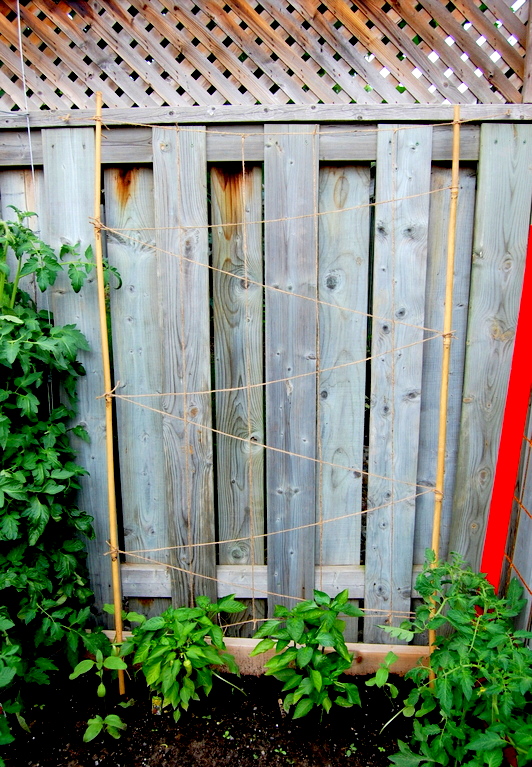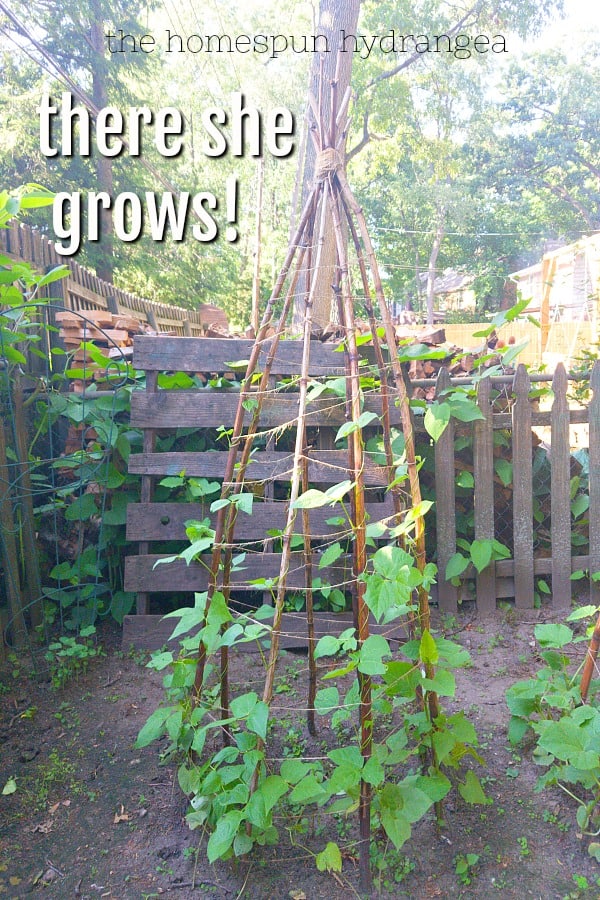To build a pole bean trellis, start by hammering stakes into the ground at equal intervals. Then, connect the stakes with horizontal support beams using wire or twine, creating a grid that will support the bean vines as they grow.

Credit: northstoryandco.com
How to Build a Pole Bean Trellis : Step by Step Guide
Choosing The Right Materials For Your Pole Bean Trellis
When constructing a pole bean trellis, it is important to choose the right materials to ensure stability and durability. There are several options available, each with their own pros and cons.
| Material | Pros | Cons |
|---|---|---|
| Bamboo | Budget-friendly and easily accessible. Environmentally friendly option. Can be cut to desired sizes. | May rot over time and require replacement. Can be prone to bending or breaking under heavy loads. |
| Metal | Durable and sturdy. Can withstand heavy loads. Provides long-term support. | Can be expensive. May rust or corrode over time if not properly maintained. |
| Wood | Natural and aesthetically pleasing. Can be customized to fit specific needs. Provides good support. | Requires regular maintenance to prevent rotting or warping. May be more expensive than other options. |
Each material option has its own benefits and drawbacks, so it is important to evaluate your specific needs and preferences when choosing the right materials for your pole bean trellis. Consider factors such as budget, availability, durability, and maintenance requirements before making your final decision.
Planning And Designing Your Pole Bean Trellis
Assessing your garden space and layout is crucial when planning and designing your pole bean trellis. Start by measuring the available area to ensure you have enough space for the trellis. Consider factors such as sunlight exposure and proximity to other plants. Determine the ideal placement for your trellis to optimize growing conditions for your pole beans.
Determining the height and width of your trellis is another important step. Pole beans require a sturdy structure that can support their weight, so consider the height carefully. Plan for a trellis that is at least 6 to 8 feet tall to allow ample vertical growth. The width of the trellis will depend on the number of pole bean plants you intend to grow.
To bring your trellis design to life, sketch out the design and dimensions for your trellis. Visualize how it will fit in your garden and consider any specific needs or constraints you have. A simple diagram can help you plan the materials needed and guide the construction process.
Constructing The Framework Of Your Pole Bean Trellis
Constructing the Framework of Your Pole Bean Trellis
Start by selecting the ideal location for your pole bean trellis. Find an area with sufficient sunlight and well-draining soil. Begin by digging holes for the support poles. The depth of the holes should be around 2 feet to ensure stability. Make sure to space the holes evenly apart, allowing for proper growth of the pole beans.
Setting the support poles firmly in the ground:
Once the holes are dug, place the support poles into the holes. Ensure that the poles are straight and upright. Use a level to check for accuracy. Once the poles are positioned correctly, backfill the holes with soil and firmly pack it down. This will provide additional stability to the trellis.
To enhance the stability of the pole bean trellis, add crossbeams between the support poles. Measure and cut the crossbeams to fit securely between the poles. Attach the crossbeams using screws or nails, ensuring they are firmly fastened. These crossbeams will provide extra support and prevent the poles from shifting or tilting.
Selecting And Installing Climbing Support For Your Pole Bean Trellis
When it comes to building a pole bean trellis, selecting and installing the climbing support plays a crucial role. There are different types of support options available for beans to climb, including stakes, tripods, teepees, and trellis netting. The choice depends on the space available, personal preference, and the number of beans to be grown.
Once the support option is chosen, attaching it to the trellis framework is important. Sturdy materials such as bamboo, wood, or metal should be used to ensure the support can withstand the weight of the climbing beans. Properly securing the climbing support to the trellis framework is necessary to prevent any collapsing or damage to the plants.
By following these guidelines, you can successfully build a pole bean trellis that provides the necessary support for your beans to climb and grow.
Planting And Training Your Pole Beans On The Trellis
Preparing the soil is the first step in building a pole bean trellis. Make sure the soil is well-drained and enriched with organic matter. Clear the area of any weeds or debris, and then dig a trench at the base of the trellis. Plant the pole beans in the trench, spacing them according to the seed packet instructions. Water the beans thoroughly after planting.
Once the bean plants start to grow, they will need some initial support to begin climbing the trellis. Use stakes or bamboo poles to create a framework for the plants to cling to. Secure the stakes or poles firmly in the ground, and gently tie the bean plants to them using soft twine or plant ties. This will help the plants start their upward journey.
As the bean plants continue to grow, regular training and guidance are essential. Monitor the plants regularly and gently guide the climbing vines towards the trellis. Be careful not to damage the plants in the process. As the plants reach the trellis, they will naturally start to twine themselves around the supports. However, you may need to provide additional guidance for any stray vines or branches.
Maintenance And Care Tips For Your Pole Bean Trellis
Maintenance and Care Tips for Your Pole Bean Trellis
To ensure the success of your pole bean trellis, it is important to provide proper watering and fertilizing. Pole beans require consistent moisture throughout their growing season, so regular watering is crucial. Water deeply, avoiding overhead irrigation to prevent diseases. Using organic mulch around the base of the plants can help retain moisture.
Pruning and trimming the bean plants as they grow
Regularly prune and trim your pole bean plants to promote healthy growth and prevent overcrowding. Pinch off the tips of the plants when they reach the desired height to encourage lateral branching. This will result in more bean production. Remove any damaged, diseased, or yellowing leaves to maintain plant health.
Inspecting and repairing any damages to the trellis
Regularly inspect your pole bean trellis for any damages or weaknesses. Repair or replace any broken or damaged parts immediately to prevent the trellis from collapsing under the weight of the plants. Ensuring the stability and integrity of the trellis will support the growth and climbing of the pole beans.
Harvesting And Enjoying Your Pole Beans
The first step in harvesting your pole beans is recognizing when they are ready. Look for full-sized pods that are tender, crisp, and bright in color. Avoid harvesting beans that are overgrown, as they tend to be tough and less flavorful. Once you have identified the perfect pods, use a pair of sharp scissors or garden shears to cut them from the vine. Cutting rather than pulling prevents damage to the plant.
To maximize your yield, make sure to harvest regularly. Continuously pick the ripe beans every few days, as this encourages the plant to produce more. Be diligent in your harvesting to prevent the beans from becoming overly mature or stringy, which affects their taste. Remember to check underneath the foliage, as beans can hide amidst the leaves.
Now that you have a bountiful harvest of pole beans, it’s time to enjoy them in delicious recipes. Pole beans can be enjoyed cooked or raw and are a versatile ingredient in various dishes. Try steaming them and tossing with a sprinkle of salt and a drizzle of olive oil for a simple and nutritious side dish. You could also incorporate them into stir-fries, soups, or salads to add a pop of freshness. Don’t forget to experiment and get creative!
Troubleshooting Common Issues With Your Pole Bean Trellis
Troubleshooting Common Issues with Your Pole Bean Trellis
Pests and diseases can be a headache when it comes to maintaining a healthy pole bean trellis. To avoid these problems, it’s important to regularly inspect your plants and take appropriate action. Keep an eye out for pests like aphids, slugs, and bean beetles. These can be controlled by using organic insecticides or by handpicking them off the plants.
In addition to pests, diseases such as powdery mildew and bean rust can also affect your bean plants. To prevent the spread of diseases, make sure to plant disease-resistant bean varieties and provide proper air circulation around the plants. Applying a fungicide early in the season can also help.
Another common issue with pole bean trellises is weak or damaged components. If you notice any broken or loose parts, repair or replace them immediately. Reinforce the trellis by tying it securely to supporting structures, such as stakes or fences, to ensure it can bear the weight of the growing plants.
Finally, overcrowding can be a problem when growing pole beans. Be cautious not to plant too many seeds or seedlings close together, as this can lead to competition for resources and hinder proper growth. Make sure to provide sufficient support for heavy bean clusters by using nylon netting or strings attached to the trellis.
Frequently Asked Questions For How To Build A Pole Bean Trellis
How Tall Should A Trellis Be For Pole Beans?
A trellis for pole beans should be at least 8 feet tall to allow the beans to grow vertically and provide ample support.
What Is The Best Trellis For Pole Beans?
A sturdy and tall trellis with strong support poles is ideal for pole beans. It provides ample vertical space for the beans to climb and grow, ensuring maximum yield.
What Can I Use For A Trellis For Pole Beans?
Use bamboo poles or wooden stakes to create a trellis for pole beans. Simply set them in the ground and tie string or twine between them for the beans to climb.
How To Build A Pole Bean Tower?
To build a pole bean tower, start by installing sturdy supports, such as bamboo poles or metal stakes, in the ground. Make sure the supports are at least 6 feet tall. Next, tie string or twine between the supports horizontally to create a framework.
Plant pole bean seeds or seedlings at the base of each support and train the vines to climb up the tower as they grow. Harvest beans when they’re ready. Happy gardening!
Conclusion
Building a pole bean trellis is a simple and cost-effective way to support your bean plants as they grow. By following a few easy steps, you can create a sturdy structure that allows your beans to climb and thrive. With the right materials and a little bit of patience, you’ll be rewarded with a bountiful harvest of delicious pole beans.
So, go ahead and get started on building your own pole bean trellis today!

